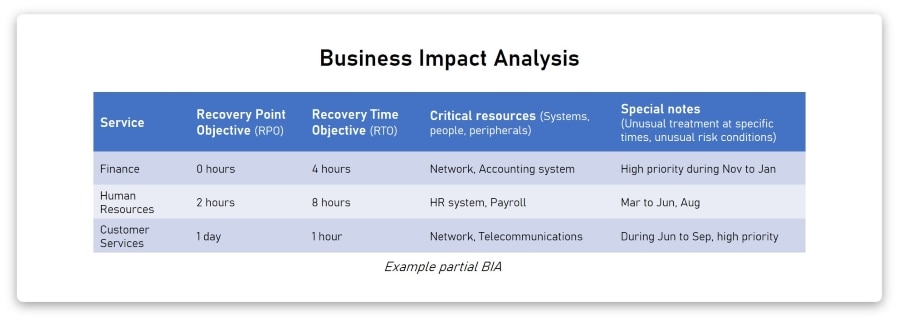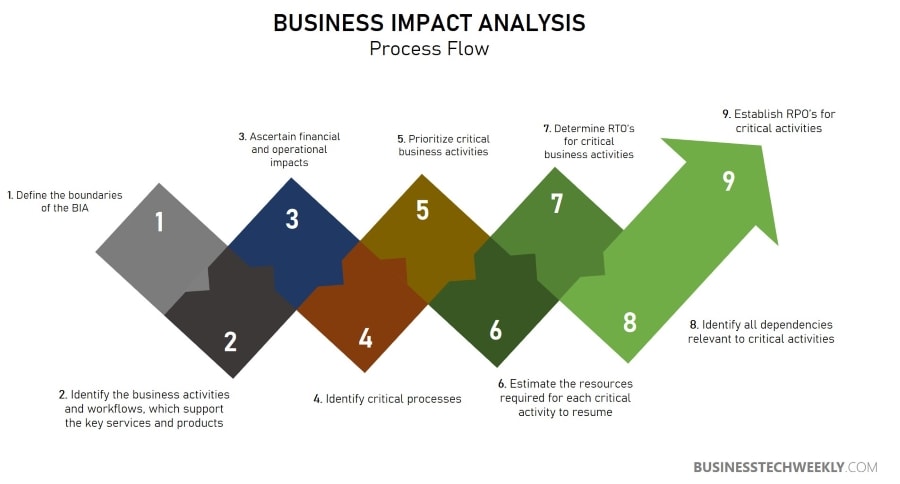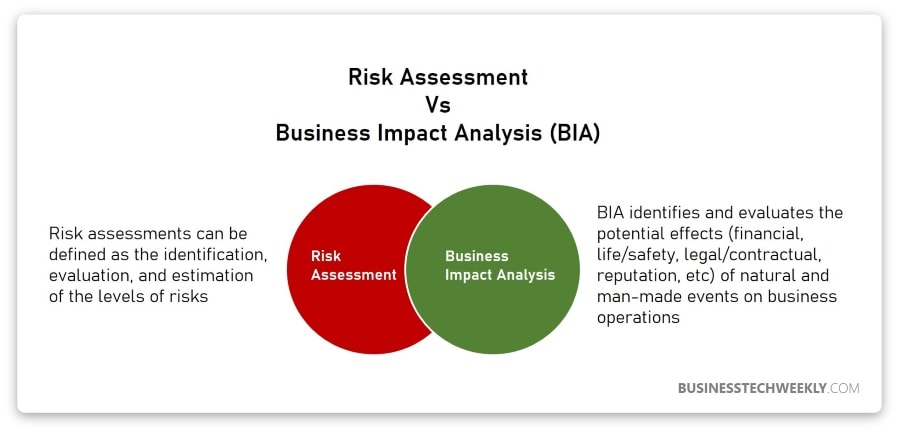Business Impact Analysis (BIA): Understanding the purpose of Business Impact Analysis

Problems, setbacks, and disruptions are inevitable in any environment. While it is not possible to prevent them from occurring, we can take measures to mitigate the effects of such events. To ensure business continuity, every organization should consider conducting business impact analysis as a part of its practices.
Below, we explain what Business Impact Analysis is, why it is essential for your organization, and how to conduct a business impact analysis for your business.
On this page:
What is Business Impact Analysis (BIA)?
Business Impact Analysis is a process of identifying critical, time-sensitive business operations and evaluating the impact of disruptions and interruptions on those operations. These interruptions may have resulted from either natural disasters or a problem in the infrastructure of the company. The information can help devise effective business continuity strategies.
A BIA is an essential component of any organization’s business continuity plan. It consists of an exploratory process to identify vulnerabilities and a planning process to create risk mitigation strategies. The overall result comes in a business impact analysis report that outlines the potential risks to the business in question.
What is the Purpose of Business Impact Analysis?
A lot of organizations fail to understand why a BIA is so essential. However, when a business continuity plan is viewed as a long-term process, the BIA proves to be a critical component that helps with information gathering. It delivers precise requirements for a successful business continuity plan.
Here are some of the essential roles of a business impact analysis:
Confirm the business continuity program scope
A business impact analysis identifies the required activities and resources for the most critical products and services and helps understand how to deliver these. In this process, the BIA uncovers the activities and resources not initially present in the scope. Moreover, understanding the impacts of disruption helps identify what resources and actions may impact the program’s scope.
Identify legal and regulatory obligations
Many businesses lack a clear understanding of their obligations. A robust business impact analysis exercise helps organizations obtain a thorough understanding of their obligations and enable the right level of business continuity planning to achieve compliance.
Clarify the business continuity strategy budget
A valuable role of BIA is to estimate the impact of a disaster in terms of downtime. A clear understanding of operational, financial, regulatory, and reputational impacts enables the organization to develop appropriate continuity strategies. The organization can be set up to identify capabilities needed to meet recovery objectives, resulting in justified spending.
Related: Recovery Time Objective (RTO) and Recovery Point Objective (RPO)
Capture preliminary content for a business continuity plan
The business impact analysis process serves as the initiation of data collection for business continuity plans. The organization, during this process, collects content like recovery strategies, contacts, team and staff requirements, and other information needed for the plan.

How to Conduct a Business Impact Analysis (BIA) for your organization
All the business impact analysis processes follow a series of steps to derive the desired results. Most BIAs have similar steps, though there is a possibility for variations depending on the business teams and analysts. Here are some general steps involved in the process.
Identify the Scope
The first step in executing a business impact analysis is ensuring that the right resources and business functions are in scope. Many employees can be sceptical about BIAs, so arranging a meeting to inform them of their purpose and use helps get their support. Next, identify what elements and areas of your business should be the center of your focus. This step also involves shortlisting the departments and people for the process.
Prepare the Report
A report should be documented for each of the departments based on the meetings and interviews. These reports contain critical information captured during the interviews and recommendations based on the information. The meeting participants review these reports, make changes and approve them.
After these reports have been completed, the organization-level BIA summary is completed. This report presents an overview of crucial resource requirements, activities, and risks identified during department-level meetings. It is a coordination of department-level BIA reports and contains recommendations based on risk assessment.
Analyze the Results
The objective of a business impact analysis is to identify the most critical business systems and functions, the resources required for optimal functioning of operations, and the period within which the functions should be recovered to restore the operations to normal. It can be either done with the help of a computer or manually.
The business impact analysis report generally consists of an executive summary, findings on different units and areas of the business, information about various data analysis methods, charts and graphs demonstrating potential losses, and recommended strategies for recovery.
The BIA report identifies priority functions, evaluates the impact of disruptions, specifies legal and regulatory requirements, outlines the acceptable levels of losses and downtime, and lists the Recovery Point Objectives and Recovery Time Objectives. The report can also list the order of activities needed to restore business operations.
The BIA report is submitted to the senior management executives who review it to devise a disaster recovery strategy and business continuity plan, considering the maximum permissible downtime and losses for business functions, reputation, finances, and information. Managers should also consider updating and reviewing the BIA at regular intervals with changing nature of business operations.
Create Recovery Strategies
A BIA helps identify costs associated with failures like replacement of equipment, loss of cash flow, loss of data, staff, and profits, cost of catching up with the backlog, and more. The BIA report also evaluates the importance of various business components and suggests suitable fund allocation for different measures devised to protect them.
It identifies the chances of failures in areas like marketing, finances, safety, quality assurance, and legal compliance. The impact of these failures is expressed in quantifiable terms wherever possible. The BIA should assess the impact of a disaster over time and help build priorities, strategies, and resource requirements for recovery.

Business Impact Analysis and Risk Assessment
The BIA and risk assessment are often talked about at the same time because they are essential steps of a business continuity plan. Most organizations perform these two processes in close coordination. A BIA generally takes place before a risk assessment.
A BIA emphasizes the effects of the disaster on critical business functions and quantifies the costs associated with the impacts. It serves as a starting point for disaster recovery strategies, identifies the RPOs and RTOs and resources needed for business continuity. On the other hand, a risk assessment identifies the potential hazards like natural calamities and infrastructure issues and evaluates the vulnerabilities.
See also: How to perform a cybersecurity risk assessment
During the risk assessment phase, the findings from the BIA report may be compared against different hazards, and based on the probability of impacts on the operations, potential disruptions are prioritized. A BIA also helps justify the spending on risk mitigation and prevention.

Common Challenges with Business Impact Analysis (BIA)
A business impact analysis, though crucial for continuity planning, is vulnerable to some problems. Here are the challenges associated with a BIA.
- It takes up too much time – For many businesses, the BIA can become time-consuming and interfere with other priorities. The organization must dedicate time to data collection and reporting based on the time surveys, and interviews can take. Organizations can also use tools and techniques to collect and process data, saving time in the process.
- Inaccurate recovery time objectives – Establishing business continuity requirements is the primary output of a BIA. Recovery time objectives help identify the most sensitive resources and activities. However, when RTOs are assigned without proper justification, it can pose a problem to the effectiveness of the BIA. To avoid such a challenge, RTOs must justify business continuity requirements.
- It doesn’t evolve with the business – BIAs are not one-time endeavors. They should be updated with the changes in the organization. BIA should be made a part of the organization’s onboarding processes so that business continuity requirements can evolve with the evolving needs and priorities.
- Too much data to analyze – Sometimes, analysts can use a too broad scope of data, resulting in an overwhelming amount of data that is difficult to analyze. An incorrect scoping method is responsible for this problem. The right scoping method is to identify the key products and services and collect data from departments involved in delivering these products and services.
- Incorrect data – Organizations may struggle with irrelevant, inaccurate, or useless data for various reasons. It can be either because of ineffective data collection methods or engaging the wrong participants. As a result, the data may be ineffective at identifying the correct requirements for business continuity.
- Uninvolved executives – The involvement of top management executives is essential for the proper direction of the business continuity strategy. Top managers are responsible for the scope and final reports of the BIA. Without properly engaged executives, there can be no strategic direction or a solid execution of required organizational changes.
Conclusion
When done right, a business impact analysis proves to be a valuable tool to organizations, helping them address disruptions better, saving resources by managing downtime and losses through effective disaster recovery and business continuity strategies.

